Chapter 7. Move and Neighborhood Selection
7.1. Move and Neighborhood Introduction
7.1.1. What is a Move?
A Move is a change (or set of changes) from a solution A to a solution B. For example, the move below changes queen C from row 0 to row 2:

The new solution is called a neighbor of the original solution, because it can be reached in a single Move. Although a single move can change multiple queens, the neighbors of a solution should always be a very small subset of all possible solutions. For example, on that original solution, these are all possible changeMoves:
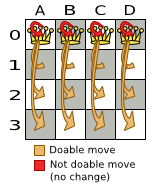
If we ignore the 4 changeMoves that have no impact and are therefore not doable, we can see that number of moves is n * (n - 1) = 12. This is far less than the number of possible solutions, which is nn = 256. As the problem scales out, the number of possible moves increases far less than the number of possible solutions.
Yet, in 4 changeMoves or less we can reach any solution. For example we can reach a very different solution in 3 changeMoves:

There are many other types of moves besides changeMoves. Many move types are included out-of-the-box, but you can also implement custom moves.
A Move can affect multiple entities or even create/delete entities. But it must not change the problem facts.
All optimization algorithms use Moves to transition from one solution to a neighbor solution. Therefore, all the optimization algorithms are confronted with Move selection: the craft of creating and iterating moves efficiently and the art of finding the most promising subset of random moves to evaluate first.
7.1.2. What is a MoveSelector?
A MoveSelector's main function is to create an Iterator<Move> when needed. An optimization algorithm will iterate through a subset of those moves.
Here’s an example how to configure a changeMoveSelector for the optimization algorithm Local Search:
<localSearch>
<changeMoveSelector/>
...
</localSearch>
Out of the box, this works and all properties of the changeMoveSelector are defaulted sensibly (unless that fails fast due to ambiguity). On the other hand, the configuration can be customized significantly for specific use cases. For example: you might want to configure a filter to discard pointless moves.
7.1.3. Subselecting of Entities, Values and Other Moves
To create a Move, a MoveSelector needs to select 1 or more planning entities and/or planning values to move. Just like MoveSelectors, EntitySelectors and ValueSelectors need to support a similar feature set (such as scalable just-in-time selection). Therefore, they all implement a common interface Selector and they are configured similarly.
A MoveSelector is often composed of EntitySelectors, ValueSelectors or even other MoveSelectors, which can be configured individually if desired:
<unionMoveSelector>
<changeMoveSelector>
<entitySelector>
...
</entitySelector>
<valueSelector>
...
</valueSelector>
...
</changeMoveSelector>
<swapMoveSelector>
...
</swapMoveSelector>
</unionMoveSelector>
Together, this structure forms a Selector tree:
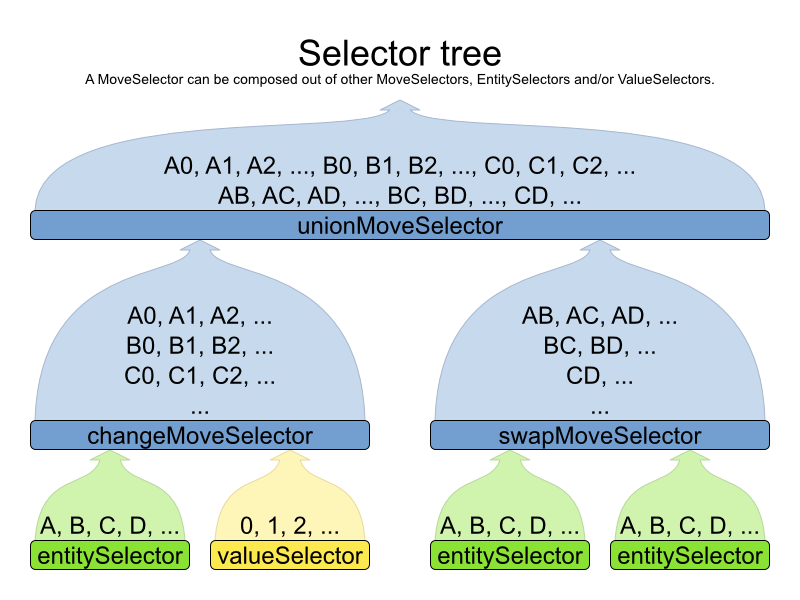
The root of this tree is a MoveSelector which is injected into the optimization algorithm implementation to be (partially) iterated in every step.
7.2. Generic MoveSelectors
7.2.1. changeMoveSelector
For 1 planning variable, the ChangeMove selects 1 planning entity and 1 planning value and assigns the entity’s variable to that value.
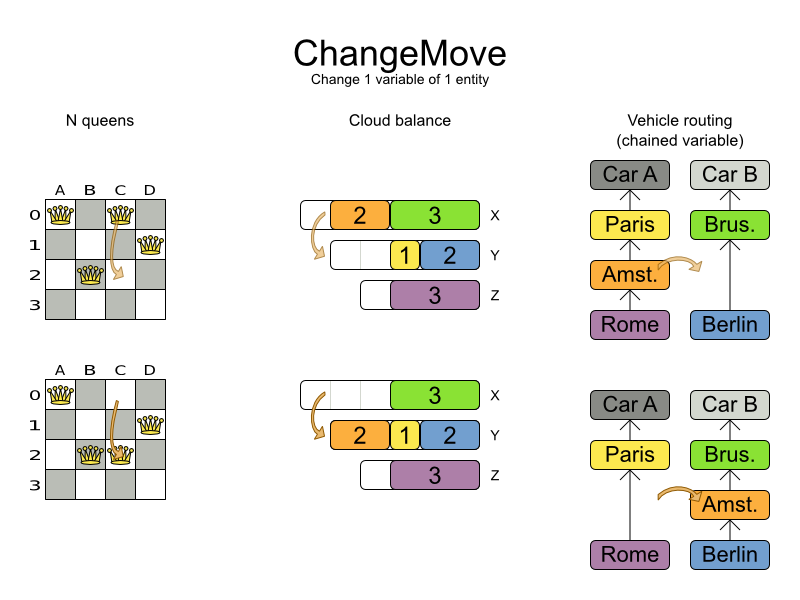
Simplest configuration:
<changeMoveSelector/>
If there are multiple entity classes or multiple planning variables for 1 entity class, a simple configuration will automatically unfold into a union of ChangeMove selectors for every planning variable.
Advanced configuration:
<changeMoveSelector>
... <!-- Normal selector properties -->
<entitySelector>
<entityClass>...Lecture</entityClass>
...
</entitySelector>
<valueSelector>
<variableName>room</variableName>
...
<nearbySelection>...</nearbySelection>
</valueSelector>
</changeMoveSelector>
A ChangeMove is the finest grained move.
Almost every moveSelector configuration injected into a metaheuristic algorithm should include a changeMoveSelector or a custom implementation. This guarantees that every possible Solution can be reached through applying a number of moves in sequence (not taking score traps into account). Of course, normally it is unioned with other, more coarse grained move selectors.
7.2.2. swapMoveSelector
The SwapMove selects 2 different planning entities and swaps the planning values of all their planning variables.
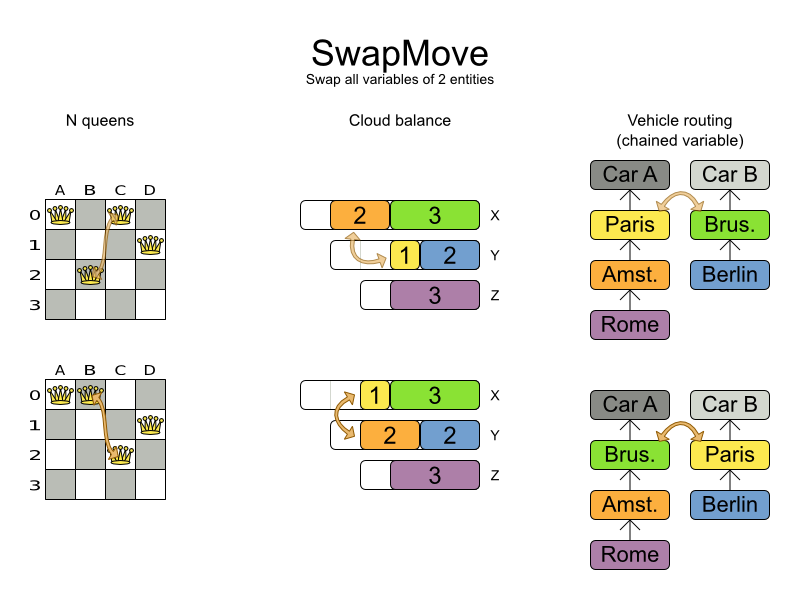
Although a SwapMove on a single variable is essentially just 2 ChangeMoves, it’s often the winning step where the first of the 2 ChangeMoves would not be the winning step because it leaves the solution in a state with broken hard constraints. For example: swapping the room of 2 lectures doesn’t bring the solution in a intermediate state where both lectures are in the same room which breaks a hard constraint.
Simplest configuration:
<swapMoveSelector/>
If there are multiple entity classes, a simple configuration will automatically unfold into a union of SwapMove selectors for every entity class.
Advanced configuration:
<swapMoveSelector>
... <!-- Normal selector properties -->
<entitySelector>
<entityClass>...Lecture</entityClass>
...
</entitySelector>
<secondaryEntitySelector>
<entityClass>...Lecture</entityClass>
...
<nearbySelection>...</nearbySelection>
</secondaryEntitySelector>
<variableNameInclude>room</variableNameInclude>
<variableNameInclude>...</variableNameInclude>
</swapMoveSelector>
The secondaryEntitySelector is rarely needed: if it is not specified, entities from the same entitySelector are swapped.
If one or more variableNameInclude properties are specified, not all planning variables will be swapped, but only those specified. For example for course scheduling, specifying only variableNameInclude room will make it only swap room, not period.
7.2.3. pillarChangeMoveSelector
A pillar is a set of planning entities which have the same planning value(s) for their planning variable(s). The PillarChangeMove selects 1 entity pillar (or subset of those) and changes the value of 1 variable (which is the same for all entities) to another value.
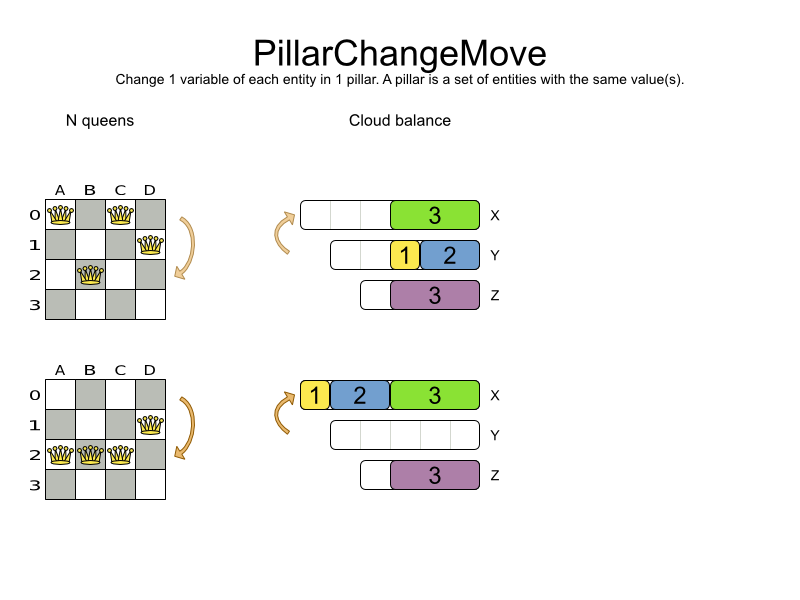
In the example above, queen A and C have the same value (row 0) and are moved to row 2. Also the yellow and blue process have the same value (computer Y) and are moved to computer X.
Simplest configuration:
<pillarChangeMoveSelector/>
Advanced configuration:
<pillarSwapMoveSelector>
... <!-- Normal selector properties -->
<pillarSelector>
<entitySelector>
<entityClass>...Lecture</entityClass>
...
</entitySelector>
<subPillarEnabled>true</subPillarEnabled>
<minimumSubPillarSize>1</minimumSubPillarSize>
<maximumSubPillarSize>1000</maximumSubPillarSize>
</pillarSelector>
<valueSelector>
<variableName>room</variableName>
...
</valueSelector>
</pillarSwapMoveSelector>
A sub pillar is a subset of entities that share the same value(s) for their variable(s). For example if queen A, B, C and D are all located on row 0, they are a pillar and [A, D] is one of the many sub pillars. If subPillarEnabled (defaults to true) is false, no sub pillars are selected. If sub pillars are enabled, the pillar itself is also included and the properties minimumSubPillarSize (defaults to 1) and maximumSubPillarSize (defaults to infinity) limit the size of the selected (sub) pillar.
The number of sub pillars of a pillar is exponential to the size of the pillar. For example a pillar of size 32 has (232 - 1) subpillars. Therefore a pillarSelector only supports JIT random selection (which is the default).
The other properties are explained in changeMoveSelector.
7.2.4. pillarSwapMoveSelector
A pillar is a set of planning entities which have the same planning value(s) for their planning variable(s). The PillarSwapMove selects 2 different entity pillars and swaps the values of all their variables for all their entities.

Simplest configuration:
<pillarSwapMoveSelector/>
Advanced configuration:
<pillarSwapMoveSelector>
... <!-- Normal selector properties -->
<pillarSelector>
<entitySelector>
<entityClass>...Lecture</entityClass>
...
</entitySelector>
<subPillarEnabled>true</subPillarEnabled>
<minimumSubPillarSize>1</minimumSubPillarSize>
<maximumSubPillarSize>1000</maximumSubPillarSize>
</pillarSelector>
<secondaryPillarSelector>
<entitySelector>
...
</entitySelector>
...
</secondaryPillarSelector>
<variableNameInclude>room</variableNameInclude>
<variableNameInclude>...</variableNameInclude>
</pillarSwapMoveSelector>
The secondaryPillarSelector is rarely needed: if it is not specified, entities from the same pillarSelector are swapped.
The other properties are explained in swapMoveSelector and pillarChangeMoveSelector.
7.2.5. tailChainSwapMoveSelector or 2-opt (chained variables only)
A tailChain is a set of planning entities with a chained planning variable which form a last part of a chain. The tailChainSwapMove selects a tail chain and swaps it with the tail chain of another planning value (in a different or the same anchor chain). If the targeted planning value doesn’t have a tail chain, it swaps with nothing (resulting in a change-like move). If it occurs within the same anchor chain, a partial chain reverse occurs. In academic papers, this is often called a 2-opt move.
Simplest configuration:
<tailChainSwapMoveSelector/>
Advanced configuration:
<subChainChangeMoveSelector>
... <!-- Normal selector properties -->
<entitySelector>
<entityClass>...Customer</entityClass>
...
</entitySelector>
<valueSelector>
<variableName>previousStandstill</variableName>
...
<nearbySelection>...</nearbySelection>
</valueSelector>
</subChainChangeMoveSelector>
The entitySelector selects the start of the tail chain that is being moved. The valueSelector selects to where that tail chain is moved. If it has a tail chain itself, that is moved to the location of the original tail chain. It uses a valueSelector instead of a secondaryEntitySelector to be able to include all possible 2-opt moves (such as moving to the end of a tail) and to work correctly with nearby selection (because of asymmetric distances and also swapped entity distance gives an incorrect selection probability).
Although subChainChangeMoveSelector and subChainSwapMoveSelector include almost every possible tailChainSwapMove, experiments have shown that focusing on tailChainSwapMoves increases efficiency.
7.2.6. subChainChangeMoveSelector (chained variables only)
A subChain is a set of planning entities with a chained planning variable which form part of a chain. The subChainChangeMoveSelector selects a subChain and moves it to another place (in a different or the same anchor chain).
Simplest configuration:
<subChainChangeMoveSelector/>
Advanced configuration:
<subChainChangeMoveSelector>
... <!-- Normal selector properties -->
<entityClass>...Customer</entityClass>
<subChainSelector>
<valueSelector>
<variableName>previousStandstill</variableName>
...
</valueSelector>
<minimumSubChainSize>2</minimumSubChainSize>
<maximumSubChainSize>40</maximumSubChainSize>
</subChainSelector>
<valueSelector>
<variableName>previousStandstill</variableName>
...
</valueSelector>
<selectReversingMoveToo>true</selectReversingMoveToo>
</subChainChangeMoveSelector>
The subChainSelector selects a number of entities, no less than minimumSubChainSize (defaults to 1) and no more than maximumSubChainSize (defaults to infinity).
If minimumSubChainSize is 1 (which is the default), this selector might select the same move as a ChangeMoveSelector, at a far lower selection probability (because each move type has the same selection chance by default (not every move instance) and there are far more SubChainChangeMove instances than ChangeMove instances). However, don’t just remove the ChangeMoveSelector, because experiments show that it’s good to focus on ChangeMoves.
Furthermore, in a SubChainSwapMoveSelector, setting minimumSubChainSize prevents swapping a subchain of size 1 with a subchain of at least size 2.
The selectReversingMoveToo property (defaults to true) enables selecting the reverse of every subchain too.
7.2.7. subChainSwapMoveSelector (chained variables only)
The subChainSwapMoveSelector selects 2 different subChains and moves them to another place in a different or the same anchor chain.
Simplest configuration:
<subChainSwapMoveSelector/>
Advanced configuration:
<subChainSwapMoveSelector>
... <!-- Normal selector properties -->
<entityClass>...Customer</entityClass>
<subChainSelector>
<valueSelector>
<variableName>previousStandstill</variableName>
...
</valueSelector>
<minimumSubChainSize>2</minimumSubChainSize>
<maximumSubChainSize>40</maximumSubChainSize>
</subChainSelector>
<secondarySubChainSelector>
<valueSelector>
<variableName>previousStandstill</variableName>
...
</valueSelector>
<minimumSubChainSize>2</minimumSubChainSize>
<maximumSubChainSize>40</maximumSubChainSize>
</secondarySubChainSelector>
<selectReversingMoveToo>true</selectReversingMoveToo>
</subChainSwapMoveSelector>
The secondarySubChainSelector is rarely needed: if it is not specified, entities from the same subChainSelector are swapped.
The other properties are explained in subChainChangeMoveSelector.
7.3. Combining Multiple MoveSelectors
7.3.1. unionMoveSelector
A unionMoveSelector selects a Move by selecting 1 of its MoveSelector children to supply the next Move.
Simplest configuration:
<unionMoveSelector>
<...MoveSelector/>
<...MoveSelector/>
<...MoveSelector/>
...
</unionMoveSelector>Advanced configuration:
<unionMoveSelector>
... <!-- Normal selector properties -->
<selectorProbabilityWeightFactoryClass>...ProbabilityWeightFactory</selectorProbabilityWeightFactoryClass>
<changeMoveSelector>
<fixedProbabilityWeight>...</fixedProbabilityWeight>
...
</changeMoveSelector>
<swapMoveSelector>
<fixedProbabilityWeight>...</fixedProbabilityWeight>
...
</swapMoveSelector>
<...MoveSelector>
<fixedProbabilityWeight>...</fixedProbabilityWeight>
...
</...MoveSelector>
...
</unionMoveSelector>
The selectorProbabilityWeightFactory determines in selectionOrder RANDOM how often a MoveSelector child is selected to supply the next Move. By default, each MoveSelector child has the same chance of being selected.
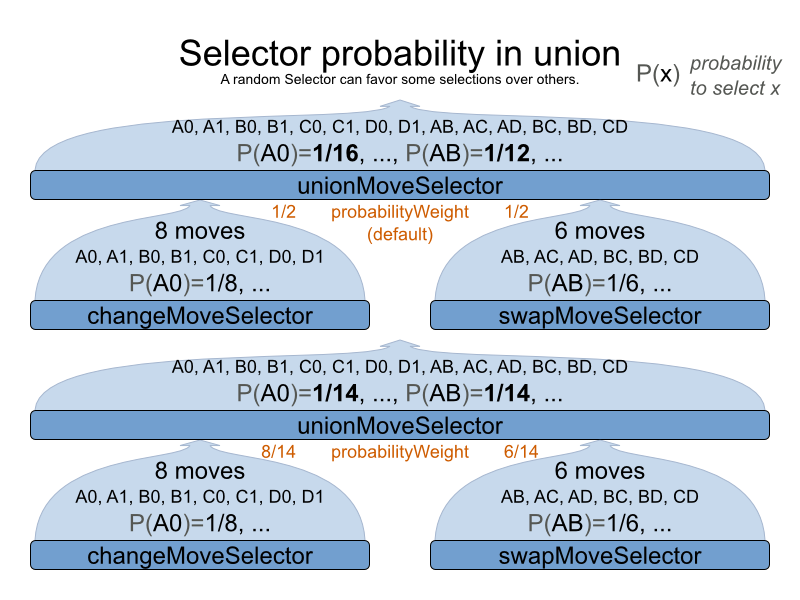
Change the fixedProbabilityWeight of such a child to select it more often. For example, the unionMoveSelector can return a SwapMove twice as often as a ChangeMove:
<unionMoveSelector>
<changeMoveSelector>
<fixedProbabilityWeight>1.0</fixedProbabilityWeight>
...
</changeMoveSelector>
<swapMoveSelector>
<fixedProbabilityWeight>2.0</fixedProbabilityWeight>
...
</swapMoveSelector>
</unionMoveSelector>
The number of possible ChangeMoves is very different from the number of possible SwapMoves and furthermore it’s problem dependent. To give each individual Move the same selection chance (as opposed to each MoveSelector), use the FairSelectorProbabilityWeightFactory:
<unionMoveSelector>
<selectorProbabilityWeightFactoryClass>org.optaplanner.core.impl.heuristic.selector.common.decorator.FairSelectorProbabilityWeightFactory</selectorProbabilityWeightFactoryClass>
<changeMoveSelector/>
<swapMoveSelector/>
</unionMoveSelector>7.3.2. cartesianProductMoveSelector
A cartesianProductMoveSelector selects a new CompositeMove. It builds that CompositeMove by selecting 1 Move per MoveSelector child and adding it to the CompositeMove.
Simplest configuration:
<cartesianProductMoveSelector>
<...MoveSelector/>
<...MoveSelector/>
<...MoveSelector/>
...
</cartesianProductMoveSelector>Advanced configuration:
<cartesianProductMoveSelector>
... <!-- Normal selector properties -->
<ignoreEmptyChildIterators>true</ignoreEmptyChildIterators>
<changeMoveSelector>
...
</changeMoveSelector>
<swapMoveSelector>
...
</swapMoveSelector>
<...MoveSelector>
...
</...MoveSelector>
...
</cartesianProductMoveSelector>
The ignoreEmptyChildIterators property (true by default) will ignore every empty childMoveSelector to avoid returning no moves. For example: a Cartesian product of changeMoveSelector A and B, for which B is empty (because all its entities are immovable) returns no move if ignoreEmptyChildIterators is false and the moves of A if ignoreEmptyChildIterators is true.
To enforce that 2 child selectors use the same entity or value efficiently, use mimic selection, not move filtering.
7.4. EntitySelector
Simplest configuration:
<entitySelector/>
Advanced configuration:
<entitySelector>
... <!-- Normal selector properties -->
<entityClass>org.optaplanner.examples.curriculumcourse.domain.Lecture</entityClass>
</entitySelector>
The entityClass property is only required if it cannot be deduced automatically because there are multiple entity classes.
7.5. ValueSelector
Simplest configuration:
<valueSelector/>
Advanced configuration:
<valueSelector>
... <!-- Normal selector properties -->
<variableName>room</variableName>
</valueSelector>
The variableName property is only required if it cannot be deduced automatically because there are multiple variables (for the related entity class).
In exotic Construction Heuristic configurations, the entityClass from the EntitySelector sometimes needs to be downcasted, which can be done with the property downcastEntityClass:
<valueSelector>
<downcastEntityClass>...LeadingExam</downcastEntityClass>
<variableName>period</variableName>
</valueSelector>
If a selected entity cannot be downcasted, the ValueSelector is empty for that entity.
7.6. General Selector Features
7.6.1. CacheType: Create Moves Ahead of Time or Just In Time
A Selector's cacheType determines when a selection (such as a Move, an entity, a value, …) is created and how long it lives.
Almost every Selector supports setting a cacheType:
<changeMoveSelector>
<cacheType>PHASE</cacheType>
...
</changeMoveSelector>
The following cacheTypes are supported:
-
JUST_IN_TIME(default): Not cached. Construct each selection (Move, …) just before it’s used. This scales up well in memory footprint. -
STEP: Cached. Create each selection (Move, …) at the beginning of a step and cache them in a list for the remainder of the step. This scales up badly in memory footprint. -
PHASE: Cached. Create each selection (Move, …) at the beginning of a solver phase and cache them in a list for the remainder of the phase. Some selections cannot be phase cached because the list changes every step. This scales up badly in memory footprint, but has a slight performance gain. -
SOLVER: Cached. Create each selection (Move, …) at the beginning of aSolverand cache them in a list for the remainder of theSolver. Some selections cannot be solver cached because the list changes every step. This scales up badly in memory footprint, but has a slight performance gain.
A cacheType can be set on composite selectors too:
<unionMoveSelector>
<cacheType>PHASE</cacheType>
<changeMoveSelector/>
<swapMoveSelector/>
...
</unionMoveSelector>
Nested selectors of a cached selector cannot be configured to be cached themselves, unless it’s a higher cacheType. For example: a STEP cached unionMoveSelector can hold a PHASE cached changeMoveSelector, but not a STEP cached changeMoveSelector.
7.6.2. SelectionOrder: Original, Sorted, Random, Shuffled or Probabilistic
A Selector's selectionOrder determines the order in which the selections (such as Moves, entities, values, …) are iterated. An optimization algorithm will usually only iterate through a subset of its MoveSelector's selections, starting from the start, so the selectionOrder is critical to decide which Moves are actually evaluated.
Almost every Selector supports setting a selectionOrder:
<changeMoveSelector>
...
<selectionOrder>RANDOM</selectionOrder>
...
</changeMoveSelector>
The following selectionOrders are supported:
ORIGINAL: Select the selections (Moves, entities, values, …) in default order. Each selection will be selected only once.- For example: A0, A1, A2, A3, …, B0, B1, B2, B3, …, C0, C1, C2, C3, …
SORTED: Select the selections (Moves, entities, values, …) in sorted order. Each selection will be selected only once. RequirescacheType ≥ STEP. Mostly used on anentitySelectororvalueSelectorfor construction heuristics. See sorted selection.- For example: A0, B0, C0, …, A2, B2, C2, …, A1, B1, C1, …
RANDOM(default): Select the selections (Moves, entities, values, …) in non-shuffled random order. A selection might be selected multiple times. This scales up well in performance because it does not require caching.- For example: C2, A3, B1, C2, A0, C0, …
SHUFFLED: Select the selections (Moves, entities, values, …) in shuffled random order. Each selection will be selected only once. RequirescacheType ≥ STEP. This scales up badly in performance, not just because it requires caching, but also because a random number is generated for each element, even if it’s not selected (which is the grand majority when scaling up).- For example: C2, A3, B1, A0, C0, …
PROBABILISTIC: Select the selections (Moves, entities, values, …) in random order, based on the selection probability of each element. A selection with a higher probability has a higher chance to be selected than elements with a lower probability. A selection might be selected multiple times. RequirescacheType ≥ STEP. Mostly used on anentitySelectororvalueSelector. See probabilistic selection.- For example: B1, B1, A1, B2, B1, C2, B1, B1, …
A selectionOrder can be set on composite selectors too.
When a Selector is cached, all of its nested Selectors will naturally default to selectionOrder ORIGINAL. Avoid overwriting the selectionOrder of those nested Selectors.
7.6.3. Recommended Combinations of CacheType and SelectionOrder
7.6.3.1. Just in Time Random Selection (default)
This combination is great for big use cases (10 000 entities or more), as it scales up well in memory footprint and performance. Other combinations are often not even viable on such sizes. It works for smaller use cases too, so it’s a good way to start out. It’s the default, so this explicit configuration of cacheType and selectionOrder is actually obsolete:
<unionMoveSelector>
<cacheType>JUST_IN_TIME</cacheType>
<selectionOrder>RANDOM</selectionOrder>
<changeMoveSelector/>
<swapMoveSelector/>
</unionMoveSelector>
Here’s how it works. When Iterator<Move>.next() is called, a child MoveSelector is randomly selected (1), which creates a random Move (2, 3, 4) and is then returned (5):

Notice that it never creates a list of Moves and it generates random numbers only for Moves that are actually selected.
7.6.3.2. Cached Shuffled Selection
This combination often wins for small and medium use cases (5000 entities or less). Beyond that size, it scales up badly in memory footprint and performance.
<unionMoveSelector>
<cacheType>PHASE</cacheType>
<selectionOrder>SHUFFLED</selectionOrder>
<changeMoveSelector/>
<swapMoveSelector/>
</unionMoveSelector>
Here’s how it works: At the start of the phase (or step depending on the cacheType), all moves are created (1) and cached (2). When MoveSelector.iterator() is called, the moves are shuffled (3). When Iterator<Move>.next() is called, the next element in the shuffled list is returned (4):

Notice that each Move will only be selected once, even though they are selected in random order.
Use cacheType PHASE if none of the (possibly nested) Selectors require STEP. Otherwise, do something like this:
<unionMoveSelector>
<cacheType>STEP</cacheType>
<selectionOrder>SHUFFLED</selectionOrder>
<changeMoveSelector>
<cacheType>PHASE</cacheType>
</changeMoveSelector>
<swapMoveSelector/>
<cacheType>PHASE</cacheType>
</swapMoveSelector>
<pillarSwapMoveSelector/><!-- Does not support cacheType PHASE -->
</unionMoveSelector>7.6.3.3. Cached Random Selection
This combination is often a worthy competitor for medium use cases, especially with fast stepping optimization algorithms (such as Simulated Annealing). Unlike cached shuffled selection, it doesn’t waste time shuffling the moves list at the beginning of every step.
<unionMoveSelector>
<cacheType>PHASE</cacheType>
<selectionOrder>RANDOM</selectionOrder>
<changeMoveSelector/>
<swapMoveSelector/>
</unionMoveSelector>7.6.4. Filtered Selection
There can be certain moves that you don’t want to select, because:
- The move is pointless and would only waste CPU time. For example, swapping 2 lectures of the same course will result in the same score and the same schedule because all lectures of 1 course are interchangeable (same teacher, same students, same topic).
Doing the move would break a built-in hard constraint, so the solution would be infeasible but the score function doesn’t check built-in hard constraints (for performance gain). For example, don’t change a gym lecture to a room which is not a gym room.
NoteAny built-in hard constraint must probably be filtered on every move type of every solver phase. For example if it filters the change move of Local Search, it must also filter the swap move that swaps the room of a gym lecture with another lecture for which the other lecture’s original room isn’t a gym room. Furthermore, it must also filter the change moves of the Construction Heuristics (which requires an advanced configuration).
Filtered selection can happen on any Selector in the selector tree, including any MoveSelector, EntitySelector or ValueSelector. It works with any cacheType and selectionOrder.
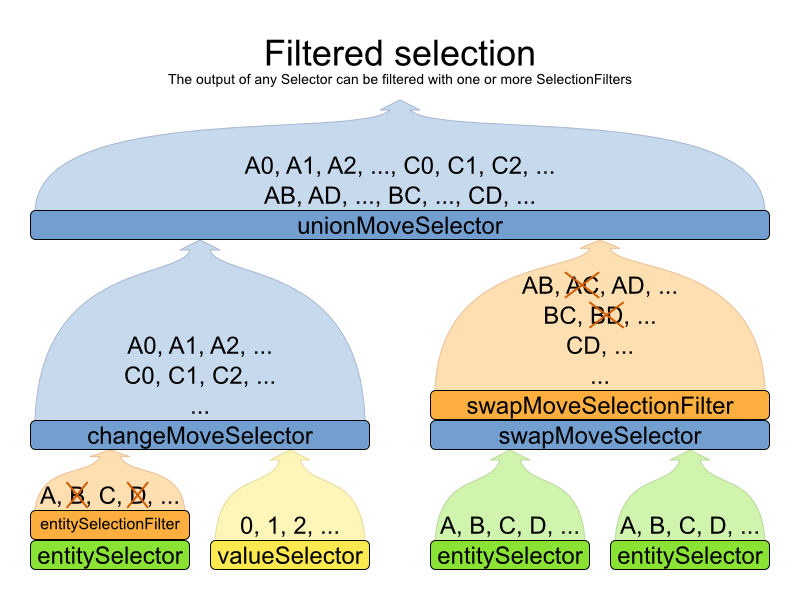
Filtering uses the interface SelectionFilter:
public interface SelectionFilter<T> {
boolean accept(ScoreDirector scoreDirector, T selection);
}
Implement the accept method to return false on a discarded selection. Unaccepted moves will not be selected and will therefore never have their doMove method called.
public class DifferentCourseSwapMoveFilter implements SelectionFilter<SwapMove> {
public boolean accept(ScoreDirector scoreDirector, SwapMove move) {
Lecture leftLecture = (Lecture) move.getLeftEntity();
Lecture rightLecture = (Lecture) move.getRightEntity();
return !leftLecture.getCourse().equals(rightLecture.getCourse());
}
}
Apply the filter on the lowest level possible. In most cases, you’ll need to know both the entity and the value involved and you’ll have to apply a filterClass on the moveSelector:
<swapMoveSelector>
<filterClass>org.optaplanner.examples.curriculumcourse.solver.move.DifferentCourseSwapMoveFilter</filterClass>
</swapMoveSelector>
But if possible, apply it on a lower level, such as a filterClass on the entitySelector or valueSelector:
<changeMoveSelector>
<entitySelector>
<filterClass>...EntityFilter</filterClass>
</entitySelector>
</changeMoveSelector>
You can configure multiple filterClass elements on a single selector.
7.6.5. Sorted Selection
Sorted selection can happen on any Selector in the selector tree, including any MoveSelector, EntitySelector or ValueSelector. It does not work with cacheType JUST_IN_TIME and it only works with selectionOrder SORTED.
It’s mostly used in construction heuristics.
If the chosen construction heuristic implies sorting, for example FIRST_FIT_DECREASING implies that the EntitySelector is sorted, there is no need to explicitly configure a Selector with sorting. If you do explicitly configure the Selector, it overwrites the default settings of that construction heuristic.
7.6.5.1. Sorted Selection by SorterManner
Some Selector types implement a SorterManner out of the box:
EntitySelectorsupports:DECREASING_DIFFICULTY: Sorts the planning entities according to decreasing planning entity difficulty. Requires that planning entity difficulty is annotated on the domain model.<entitySelector> <cacheType>PHASE</cacheType> <selectionOrder>SORTED</selectionOrder> <sorterManner>DECREASING_DIFFICULTY</sorterManner> </entitySelector>
ValueSelectorsupports:INCREASING_STRENGTH: Sorts the planning values according to increasing planning value strength. Requires that planning value strength is annotated on the domain model.<valueSelector> <cacheType>PHASE</cacheType> <selectionOrder>SORTED</selectionOrder> <sorterManner>INCREASING_STRENGTH</sorterManner> </valueSelector>DECREASING_STRENGTH: Sorts the planning values according to decreasing planning value strength. Requires that planning value strength is annotated on the domain model.<valueSelector> <cacheType>PHASE</cacheType> <selectionOrder>SORTED</selectionOrder> <sorterManner>DECREASING_STRENGTH</sorterManner> </valueSelector>
7.6.5.2. Sorted Selection by Comparator
An easy way to sort a Selector is with a plain old Comparator:
public class CloudProcessDifficultyComparator implements Comparator<CloudProcess> {
public int compare(CloudProcess a, CloudProcess b) {
return new CompareToBuilder()
.append(a.getRequiredMultiplicand(), b.getRequiredMultiplicand())
.append(a.getId(), b.getId())
.toComparison();
}
}You’ll also need to configure it (unless it’s annotated on the domain model and automatically applied by the optimization algorithm):
<entitySelector>
<cacheType>PHASE</cacheType>
<selectionOrder>SORTED</selectionOrder>
<sorterComparatorClass>...CloudProcessDifficultyComparator</sorterComparatorClass>
<sorterOrder>DESCENDING</sorterOrder>
</entitySelector>
The sorterOrder element is optional, with the default value of ASCENDING.
7.6.5.3. Sorted Selection by SelectionSorterWeightFactory
If you need to know the entire Solution to sort a Selector, use a SelectionSorterWeightFactory instead:
public interface SelectionSorterWeightFactory<Sol extends Solution, T> {
Comparable createSorterWeight(Sol solution, T selection);
}public class QueenDifficultyWeightFactory implements SelectionSorterWeightFactory<NQueens, Queen> {
public Comparable createSorterWeight(NQueens nQueens, Queen queen) {
int distanceFromMiddle = calculateDistanceFromMiddle(nQueens.getN(), queen.getColumnIndex());
return new QueenDifficultyWeight(queen, distanceFromMiddle);
}
// ...
public static class QueenDifficultyWeight implements Comparable<QueenDifficultyWeight> {
private final Queen queen;
private final int distanceFromMiddle;
public QueenDifficultyWeight(Queen queen, int distanceFromMiddle) {
this.queen = queen;
this.distanceFromMiddle = distanceFromMiddle;
}
public int compareTo(QueenDifficultyWeight other) {
return new CompareToBuilder()
// The more difficult queens have a lower distance to the middle
.append(other.distanceFromMiddle, distanceFromMiddle) // Decreasing
// Tie breaker
.append(queen.getColumnIndex(), other.queen.getColumnIndex())
.toComparison();
}
}
}You’ll also need to configure it (unless it’s annotated on the domain model and automatically applied by the optimization algorithm):
<entitySelector>
<cacheType>PHASE</cacheType>
<selectionOrder>SORTED</selectionOrder>
<sorterWeightFactoryClass>...QueenDifficultyWeightFactory</sorterWeightFactoryClass>
<sorterOrder>DESCENDING</sorterOrder>
</entitySelector>
The sorterOrder element is optional, with the default value of ASCENDING.
7.6.5.4. Sorted Selection by SelectionSorter
Alternatively, you can also use the interface SelectionSorter directly:
public interface SelectionSorter<T> {
void sort(ScoreDirector scoreDirector, List<T> selectionList);
} <entitySelector>
<cacheType>PHASE</cacheType>
<selectionOrder>SORTED</selectionOrder>
<sorterClass>...MyEntitySorter</sorterClass>
</entitySelector>7.6.6. Probabilistic Selection
Probabilistic selection can happen on any Selector in the selector tree, including any MoveSelector, EntitySelector or ValueSelector. It does not work with cacheType JUST_IN_TIME and it only works with selectionOrder PROBABILISTIC.

Each selection has a probabilityWeight, which determines the chance that selection will be selected:
public interface SelectionProbabilityWeightFactory<T> {
double createProbabilityWeight(ScoreDirector scoreDirector, T selection);
} <entitySelector>
<cacheType>PHASE</cacheType>
<selectionOrder>PROBABILISTIC</selectionOrder>
<probabilityWeightFactoryClass>...MyEntityProbabilityWeightFactoryClass</probabilityWeightFactoryClass>
</entitySelector>
For example, if there are 3 entities: process A (probabilityWeight 2.0), process B (probabilityWeight 0.5) and process C (probabilityWeight 0.5), then process A will be selected 4 times more often than B and C.
7.6.7. Limited Selection
Selecting all possible moves sometimes does not scale well enough, especially for construction heuristics (which don’t support acceptedCountLimit).
To limit the number of selected selections per step, apply a selectedCountLimit on the selector:
<changeMoveSelector>
<selectedCountLimit>100</selectedCountLimit>
</changeMoveSelector>
To scale Local Search, setting acceptedCountLimit is usually better than using selectedCountLimit.
7.6.8. Mimic Selection (Record/Replay)
During mimic selection, 1 normal selector records its selection and 1 or multiple other special selectors replay that selection. The recording selector acts as a normal selector and supports all other configuration properties. A replaying selector mimics the recording selection and support no other configuration properties.
The recording selector needs an ID. A replaying selector must reference a recorder’s ID with a mimicSelectorRef:
<cartesianProductMoveSelector>
<changeMoveSelector>
<entitySelector id="entitySelector"/>
<valueSelector>
<variableName>period</variableName>
</valueSelector>
</changeMoveSelector>
<changeMoveSelector>
<entitySelector mimicSelectorRef="entitySelector"/>
<valueSelector>
<variableName>room</variableName>
</valueSelector>
</changeMoveSelector>
</cartesianProductMoveSelector>Mimic selection is useful to create a composite move from 2 moves that affect the same entity.
7.6.9. Nearby Selection
In some use cases (such as TSP and VRP, but also in non-chained variable cases), changing entities to nearby values or swapping nearby entities can heavily increase scalability and improve solution quality.
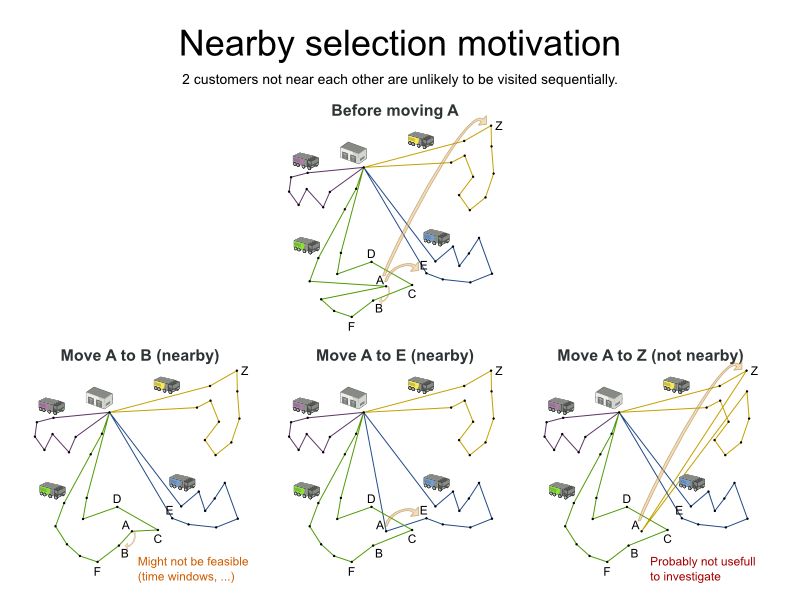
Nearby selection increases the probability of selecting an entity or value which is nearby to the first entity being moved in that move.
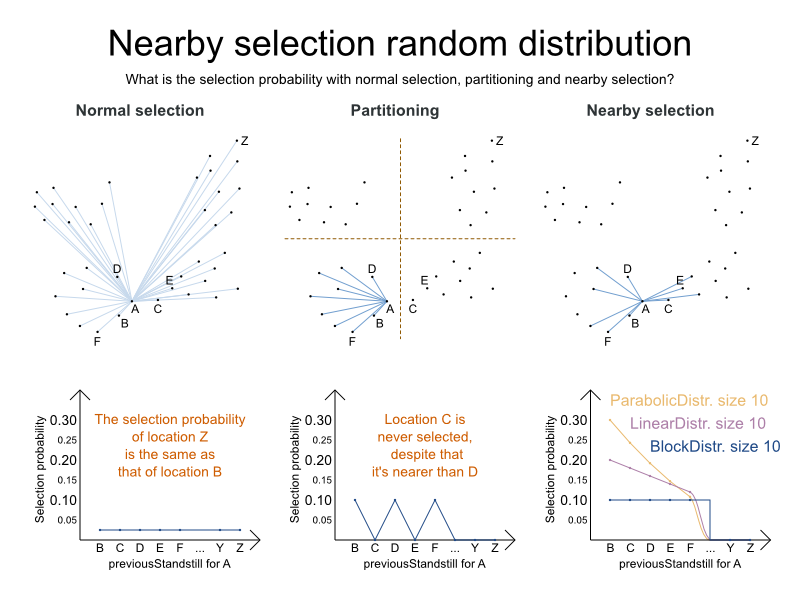
The distance between 2 entities or values is domain specific. Therefore, implement the NearbyDistanceMeter interface:
public interface NearbyDistanceMeter<O, D> {
double getNearbyDistance(O origin, D destination);
}
It returns a double which represents the distance:
public class CustomerNearbyDistanceMeter implements NearbyDistanceMeter<Customer, Standstill> {
public double getNearbyDistance(Customer origin, Standstill destination) {
return origin.getDistanceTo(destination);
}
}
To configure nearby selection, add a nearbySelection element in the entitySelector or valueSelector and use mimic selection to specify which entity should be near by the selection.
<unionMoveSelector>
<changeMoveSelector>
<entitySelector id="entitySelector1"/>
<valueSelector>
<nearbySelection>
<originEntitySelector mimicSelectorRef="entitySelector1"/>
<nearbyDistanceMeterClass>...CustomerNearbyDistanceMeter</nearbyDistanceMeterClass>
<parabolicDistributionSizeMaximum>40</parabolicDistributionSizeMaximum>
</nearbySelection>
</valueSelector>
</changeMoveSelector>
<swapMoveSelector>
<entitySelector id="entitySelector2"/>
<secondaryEntitySelector>
<nearbySelection>
<originEntitySelector mimicSelectorRef="entitySelector2"/>
<nearbyDistanceMeterClass>...CustomerNearbyDistanceMeter</nearbyDistanceMeterClass>
<parabolicDistributionSizeMaximum>40</parabolicDistributionSizeMaximum>
</nearbySelection>
</secondaryEntitySelector>
</swapMoveSelector>
<tailChainSwapMoveSelector>
<entitySelector id="entitySelector3"/>
<valueSelector>
<nearbySelection>
<originEntitySelector mimicSelectorRef="entitySelector3"/>
<nearbyDistanceMeterClass>...CustomerNearbyDistanceMeter</nearbyDistanceMeterClass>
<parabolicDistributionSizeMaximum>40</parabolicDistributionSizeMaximum>
</nearbySelection>
</valueSelector>
</tailChainSwapMoveSelector>
</unionMoveSelector>
A distributionSizeMaximum parameter should not be 1 because if the nearest is already the planning value of the current entity, then the only move that is selectable is not doable.
To allow every element to be selected, regardless of the number of entities, only set the distribution type (so without a distributionSizeMaximum parameter):
<nearbySelection>
<nearbySelectionDistributionType>PARABOLIC_DISTRIBUTION</nearbySelectionDistributionType>
</nearbySelection>
The following NearbySelectionDistributionTypes are supported:
BLOCK_DISTRIBUTION: Only the n nearest are selected, with an equal probability. For example, select the 20 nearest:<nearbySelection> <blockDistributionSizeMaximum>20</blockDistributionSizeMaximum> </nearbySelection>LINEAR_DISTRIBUTION: Nearest elements are selected with a higher probability. The probability decreases linearly.<nearbySelection> <linearDistributionSizeMaximum>40</linearDistributionSizeMaximum> </nearbySelection>PARABOLIC_DISTRIBUTION(recommended): Nearest elements are selected with a higher probability.<nearbySelection> <parabolicDistributionSizeMaximum>80</parabolicDistributionSizeMaximum> </nearbySelection>BETA_DISTRIBUTION: Selection according to a beta distribution. Slows down the solver significantly.<nearbySelection> <betaDistributionAlpha>1</betaDistributionAlpha> <betaDistributionBeta>5</betaDistributionBeta> </nearbySelection>
As always, use the Benchmarker to tweak values if desired.
7.7. Custom Moves
7.7.1. Which Move Types Might be Missing in my Implementation?
To determine which move types might be missing in your implementation, run a Benchmarker for a short amount of time and configure it to write the best solutions to disk. Take a look at such a best solution: it will likely be a local optimum. Try to figure out if there’s a move that could get out of that local optimum faster.
If you find one, implement that coarse-grained move, mix it with the existing moves and benchmark it against the previous configurations to see if you want to keep it.
7.7.2. Custom Moves Introduction
Instead of reusing the generic Moves (such as ChangeMove) you can also implement your own Moves. Generic and custom MoveSelectors can be combined as desired.
A custom Move can be tailored to work to the advantage of your constraints. For example, in examination scheduling, changing the period of an exam A also changes the period of all the exams that need to coincide with exam A.
A custom Move is also slightly faster than a generic Move. However, it’s far more work to implement and much harder to avoid bugs. After implementing a custom Move, make sure to turn on environmentMode FULL_ASSERT to check for score corruptions.
7.7.3. The Move Interface
Your custom moves must implement the Move interface:
public interface Move {
boolean isMoveDoable(ScoreDirector scoreDirector);
Move createUndoMove(ScoreDirector scoreDirector);
void doMove(ScoreDirector scoreDirector);
Collection<? extends Object> getPlanningEntities();
Collection<? extends Object> getPlanningValues();
}
Let’s take a look at the Move implementation for 4 queens which moves a queen to a different row:
public class RowChangeMove extends AbstractMove {
private Queen queen;
private Row toRow;
public RowChangeMove(Queen queen, Row toRow) {
this.queen = queen;
this.toRow = toRow;
}
// ... see below
}
An instance of RowChangeMove moves a queen from its current row to a different row.
Planner calls the doMove(ScoreDirector) method to do a move, which calls doMoveOnGenuineVariables(ScoreDirector). The Move implementation must notify the ScoreDirector of any changes it makes to planning entity’s variables:
public void doMoveOnGenuineVariables(ScoreDirector scoreDirector) {
scoreDirector.beforeVariableChanged(queen, "row"); // before changes are made to the queen.row
queen.setRow(toRow);
scoreDirector.afterVariableChanged(queen, "row"); // after changes are made to the queen.row
}
You need to call the scoreDirector.beforeVariableChanged(Object, String) and scoreDirector.afterVariableChanged(Object, String) methods directly before and after modifying the entity.
You can alter multiple entities in a single move and effectively create a big move (also known as a coarse-grained move).
A Move can only change/add/remove planning entities, it must not change any of the problem facts.
Planner automatically filters out non doable moves by calling the isMoveDoable(ScoreDirector) method on a move. A non doable move is:
- A move that changes nothing on the current solution. For example, moving queen B0 to row 0 is not doable, because it is already there.
- A move that is impossible to do on the current solution. For example, moving queen B0 to row 10 is not doable because it would move it outside the board limits.
In the n queens example, a move which moves the queen from its current row to the same row isn’t doable:
public boolean isMoveDoable(ScoreDirector scoreDirector) {
return !ObjectUtils.equals(queen.getRow(), toRow);
}
Because we won’t generate a move which can move a queen outside the board limits, we don’t need to check it. A move that is currently not doable could become doable on the working Solution of a later step.
Each move has an undo move: a move (normally of the same type) which does the exact opposite. In the example above the undo move of C0 to C2 would be the move C2 to C0. An undo move is created from a Move, before the Move has been done on the current solution.
public Move createUndoMove(ScoreDirector scoreDirector) {
return new RowChangeMove(queen, queen.getRow());
}Notice that if C0 would have already been moved to C2, the undo move would create the move C2 to C2, instead of the move C2 to C0.
A solver phase might do and undo the same Move more than once. In fact, many solver phases will iteratively do and undo a number of moves to evaluate them, before selecting one of those and doing that move again (without undoing it this time).
A Move must implement the getPlanningEntities() and getPlanningValues() methods. They are used by entity tabu and value tabu respectively. When they are called, the Move has already been done.
public List<? extends Object> getPlanningEntities() {
return Collections.singletonList(queen);
}
public Collection<? extends Object> getPlanningValues() {
return Collections.singletonList(toRow);
}
If your Move changes multiple planning entities, return all of them in getPlanningEntities() and return all their values (to which they are changing) in getPlanningValues().
public Collection<? extends Object> getPlanningEntities() {
return Arrays.asList(leftCloudProcess, rightCloudProcess);
}
public Collection<? extends Object> getPlanningValues() {
return Arrays.asList(leftCloudProcess.getComputer(), rightCloudProcess.getComputer());
}
A Move must implement the equals() and hashCode() methods. 2 moves which make the same change on a solution, should be equal.
public boolean equals(Object o) {
if (this == o) {
return true;
} else if (o instanceof RowChangeMove) {
RowChangeMove other = (RowChangeMove) o;
return new EqualsBuilder()
.append(queen, other.queen)
.append(toRow, other.toRow)
.isEquals();
} else {
return false;
}
}
public int hashCode() {
return new HashCodeBuilder()
.append(queen)
.append(toRow)
.toHashCode();
}
Notice that it checks if the other move is an instance of the same move type. This instanceof check is important because a move will be compared to a move with another move type if you’re using more than 1 move type.
Implement the toString() method to keep Planner’s logs readable:
public String toString() {
return queen + " {" + queen.getRow() + " -> " + toRow + "}";
}
Now that we can implement a single custom Move, let’s take a look at generating such custom moves.
7.7.4. MoveListFactory: the Easy Way to Generate Custom Moves
The easiest way to generate custom moves is by implementing the interface MoveListFactory:
public interface MoveListFactory<S extends Solution> {
List<Move> createMoveList(S solution);
}For example:
public class RowChangeMoveFactory implements MoveListFactory<NQueens> {
public List<Move> createMoveList(NQueens nQueens) {
List<Move> moveList = new ArrayList<Move>();
for (Queen queen : nQueens.getQueenList()) {
for (Row toRow : nQueens.getRowList()) {
moveList.add(new RowChangeMove(queen, toRow));
}
}
return moveList;
}
}
Simple configuration (which can be nested in a unionMoveSelector just like any other MoveSelector):
<moveListFactory>
<moveListFactoryClass>org.optaplanner.examples.nqueens.solver.move.factory.RowChangeMoveFactory</moveListFactoryClass>
</moveListFactory>Advanced configuration:
<moveListFactory>
... <!-- Normal moveSelector properties -->
<moveListFactoryClass>org.optaplanner.examples.nqueens.solver.move.factory.RowChangeMoveFactory</moveListFactoryClass>
</moveListFactory>
Because the MoveListFactory generates all moves at once in a List<Move>, it does not support cacheType JUST_IN_TIME. Therefore, moveListFactory uses cacheType STEP by default and it scales badly in memory footprint.
7.7.5. MoveIteratorFactory: Generate Custom Moves Just in Time
Use this advanced form to generate custom moves by implementing the MoveIteratorFactory interface:
public interface MoveIteratorFactory {
long getSize(ScoreDirector scoreDirector);
Iterator<Move> createOriginalMoveIterator(ScoreDirector scoreDirector);
Iterator<Move> createRandomMoveIterator(ScoreDirector scoreDirector, Random workingRandom);
}
The getSize() method must give an estimation of the size. It doesn’t need to be correct. The createOriginalMoveIterator method is called if the selectionOrder is ORIGINAL or if it is cached. The createRandomMoveIterator method is called for selectionOrder RANDOM combined with cacheType JUST_IN_TIME.
Don’t create a collection (list, array, map, set) of Moves when creating the Iterator<Move>: the whole purpose of MoveIteratorFactory over MoveListFactory is giving you the ability to create a Move just in time in the Iterator's method next().
Simple configuration (which can be nested in a unionMoveSelector just like any other MoveSelector):
<moveIteratorFactory>
<moveIteratorFactoryClass>...</moveIteratorFactoryClass>
</moveIteratorFactory>Advanced configuration:
<moveIteratorFactory>
... <!-- Normal moveSelector properties -->
<moveIteratorFactoryClass>...</moveIteratorFactoryClass>
</moveIteratorFactory>
